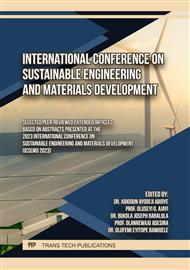[1]
Smereka M, Spyra A, Mendera K. Mass fraction burned analysis. J KONES. 2002;9(3):193–201.
Google Scholar
[2]
Garrido Gonzalez N, Baar R, Drueckhammer J, Kaeppner C. The Thermodynamics of Exhaust Gas Condensation. SAE Int J Engines. 2017;10(4):1411–21.
DOI: 10.4271/2017-01-9281
Google Scholar
[3]
Scuderi CJ. Split Four Stroke Engine. 2003;2(12).
Google Scholar
[4]
Ge Y, Chen L, Sun F. Progress in finite time thermodynamic studies for internal combustion engine cycles. Entropy. 2016;18(4).
DOI: 10.3390/e18040139
Google Scholar
[5]
Jangam SP, Kumar S, Maheshwari S. Literature review on analysis of various components of IC engine. Mater Today Proc [Internet]. 2018;5(9):19027–33. Available from:
DOI: 10.1016/j.matpr.2018.06.254
Google Scholar
[6]
RC Flange. Internal Engines. AirPollution88 [Internet]. 1988;226–89. Available from: http://resolver.caltech.edu/CaltechBOOK:1988.001
Google Scholar
[7]
Zhang Y. Book Review: Fundamentals of Engineering Thermodynamics. Vol. 29, International Journal of Mechanical Engineering Education. 2001. 12–12 p.
Google Scholar
[8]
Shapiro MiJM and HN. Fundamentals of Engineering Thermodynamics. Inc JW and S, editor. Fith Edition. Canada; 2021. 150–170 p.
Google Scholar
[9]
Heywood JB. The Internal Combustion Engine Fundamentals. 2015. 1–27 p.
Google Scholar
[10]
Richard M. Felder and Ronald W. Rousseau. Elementary Principles of Chemical Process. Third Edit. Angewandte Chemie International Edition. Canada: John Wiley and Sons, Inc; 2005.
Google Scholar
[11]
Caton JA. The thermodynamic characteristics of high efficiency, internal-combustion engines. Energy Convers Manag [Internet]. 2012;58:84–93. Available from:
DOI: 10.1016/j.enconman.2012.01.005
Google Scholar
[12]
Taylor AMKP. Science review of internal combustion engines. Energy Policy. 2008;36(12):4657–67.
Google Scholar
[13]
Magdas VB, Mastan DC, Burnete N. Simulation possibilities of the internal combustion engine management elements using Lotus Engine Simulation software. IOP Conf Ser Mater Sci Eng. 2020;997(1).
DOI: 10.1088/1757-899x/997/1/012121
Google Scholar
[14]
Mshelia UB. Simulation of Fluid Flow In The Exhaust of An Internal Combustion Engine. 2015;8(1):13–21.
Google Scholar
[15]
Bala E, Momoh OR, Aderemi BO, El-Yakubu BJ. Production and characterization of carbon molecular sieves from bituminous lafia-obi nasarawa coal by pore size modification with spent engine oil. South African J Chem. 2019;72:16–20.
DOI: 10.17159/0379-4350/2019/v72a3
Google Scholar
[16]
Kang Z, Chen S, Wu Z, Deng J, Hu Z, Li L. Simulation Study of Water Injection Strategy in Improving Cycle Efficiency Based on a Novel Compression Ignition Oxy-Fuel Combustion Engine. SAE Int J Engines. 2018;11(6):935–45.
DOI: 10.4271/2018-01-0894
Google Scholar
[17]
Yang X, Epiepang FE, Li J, Wei Y, Liu Y, Yang RT. Sr-LSX zeolite for air separation. Chem Eng J. 2019 Apr 15;362:482–6.
DOI: 10.1016/j.cej.2019.01.066
Google Scholar
[18]
Hutson ND, Zajic SC, Yang RT. Influence of residual water on the adsorption of atmospheric gases in Li-X zeolite: Experiment and simulation. Ind Eng Chem Res [Internet]. 2000 [cited 2021 Mar 12];39(6):1775–80. Available from: https://pubs.acs.org/sharingguidelines
DOI: 10.1021/ie990763z
Google Scholar
[19]
Ben-Mansour R, Habib MA, Bamidele OE, Basha M, Qasem NAA, Peedikakkal A, et al. Carbon capture by physical adsorption: Materials, experimental investigations and numerical modeling and simulations - A review.Vol.161, Applied Energy. Elsevier Ltd; 2016. p.225–55.
DOI: 10.1016/j.apenergy.2015.10.011
Google Scholar
[20]
Rzepka P. The chemical nature of CO 2 adsorption in zeolite A [Internet]. 2019 [cited 2021 May 6]. Available from: http://urn.kb.se/resolve?urn=urn:nbn:se:su:diva-162364
Google Scholar
[21]
A. Demirbas, M. A. Balubaid, A. M. Basahel, W. Ahmad & M. H. Sheikh (2015) Octane Rating of Gasoline and Octane Booster Additives, Petroleum Science and Technology, 33:11, 1190-1197
DOI: 10.1080/10916466.2015.1050506
Google Scholar
[22]
Volkswagem. Motor vehicles: Exhaust emission, Composition, Emission Control, Standards. Nature. 2012;231(5297):16–7.
Google Scholar
[23]
Hsueh MH, Wang CN, Hsieh MC, Lai CJ, Wang SH, Hsieh CH, et al. An Analysis of Exhaust Emission of the Internal Combustion Engine Treated by the Non-Thermal Plasma. Molecules. 2020;25(24):1–20.
DOI: 10.3390/molecules25246041
Google Scholar
[24]
Harkins J, Goodwine JK. Oxides of nitrogen in diesel exhaust. J Air Pollut Control Assoc. 1964;14(1):34–8.
DOI: 10.1080/00022470.1964.10468238
Google Scholar
[25]
Catalysts SZ, Martens JA, Cauvel A, Francis A, Jayat F, Remy M, et al. COMMUNICATIONS NO x Abatement in Exhaust from Lean-Burn. 1998;(2):1901–3.
DOI: 10.1002/(sici)1521-3773(19980803)37:13/14<1901::aid-anie1901>3.0.co;2-9
Google Scholar
[26]
Ściubidło A, Majchrzak-Kucęba I. Exhaust gas purification process using fly ash-based sorbents. Fuel [Internet]. 2019;258(September):116126. Available from: https://doi.org/
DOI: 10.1016/j.fuel.2019.116126
Google Scholar
[27]
Abdel-Rahman AA. On the Emissions from Internal-Combustion Engines: A Re»Ie¼. Vol. 22, Int. J. Energy Res. 1998.
Google Scholar
[28]
Bonatesta F, Waters B, Shayler PJ. Burn angles and form factors for Wiebe function fits to mass fraction burned curves of a spark ignition engine with variable valve timing. Int J Engine Res [Internet]. 2010 Apr 21 [cited 2021 Feb 9];11(2):177–86. Available from: http://journals.sagepub.com/doi/
DOI: 10.1243/14680874JER05009
Google Scholar
[29]
Caton JA. The thermodynamics of internal combustion engines: Examples of insights. Inventions. 2018;3(2).
DOI: 10.3390/inventions3020033
Google Scholar
[30]
Nursalam, 2016 metode penelitian, Fallis A. 済無No Title No Title. J Chem Inf Model. 2013;53(9):1689–99.
Google Scholar
[31]
Wu CW, Chen RH, Pu JY, Lin TH. The influence of air-fuel ratio on engine performance and pollutant emission of an SI engine using ethanol-gasoline-blended fuels. In: Atmospheric Environment. Elsevier Ltd; 2004. p.7093–100.
DOI: 10.1016/j.atmosenv.2004.01.058
Google Scholar
[32]
Song C. Introduction to Chemistry of Diesel Fuels. In: Chemistry of Diesel Fuels [Internet]. CRC Press; 2020 [cited 2021 Jul 26]. p.1–60. Available from: https://www.taylorfrancis.com/chapters/edit/
DOI: 10.1201/9781003075455-1
Google Scholar
[33]
Spindt RS. Air-Fuel Ratios from Exhaust Gas Analysis [Internet]. Vol. 74, Transactions. 1966 [cited 2021 Apr 8]. Available from: https://about.jstor.org/terms
Google Scholar



